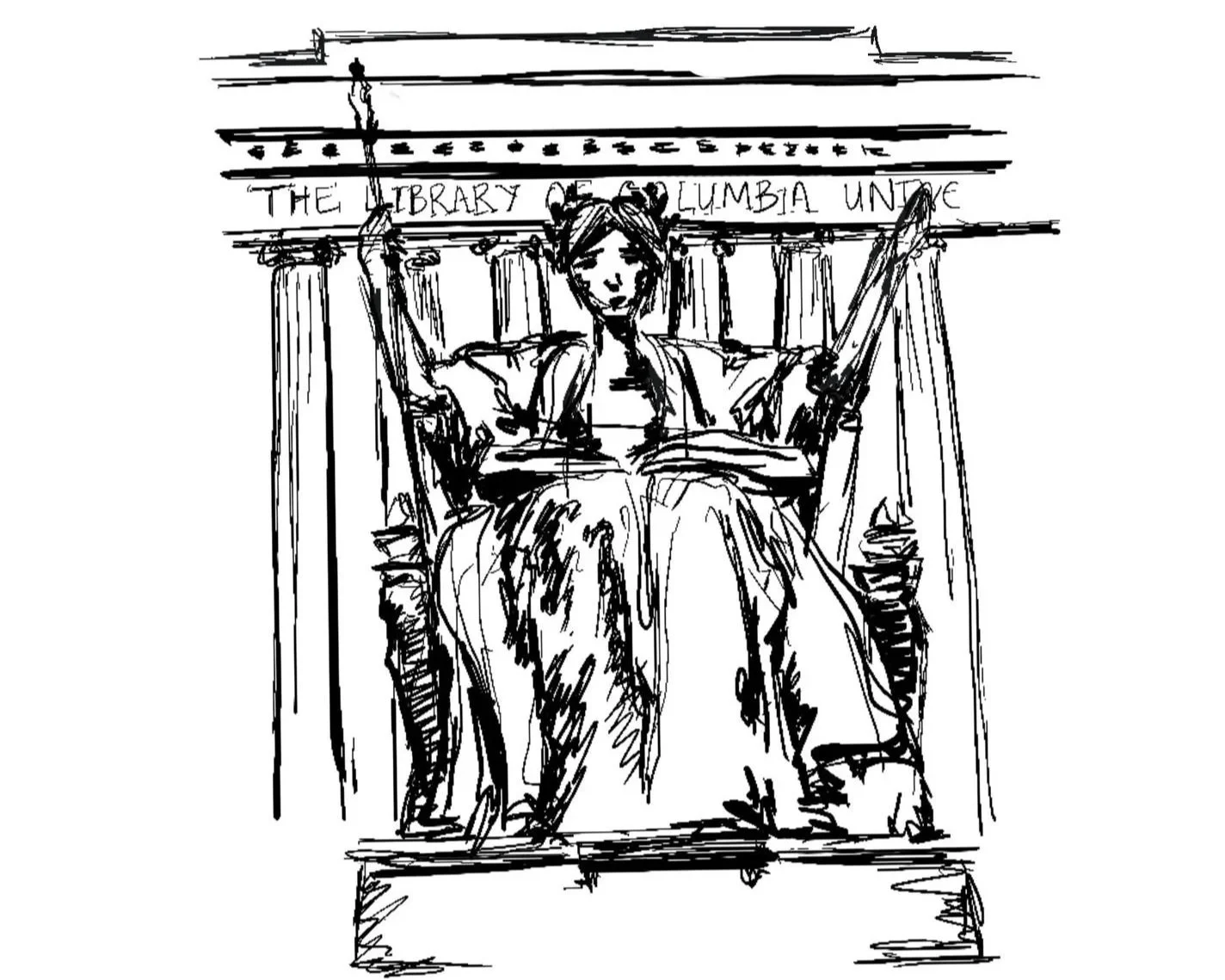Reading Columbia’s Colonial Campus: How Architecture Shapes Student Consciousness
Illustration/Sneha Sinha)
By David Sathuluri
Every day, thousands of Columbia University students climb the granite steps of Low Library and pass by Daniel Chester French's bronze Alma Mater statue. But they miss the imperial narratives carved into our daily commute.
Columbia purchased its property from the Bloomingdale Insane Asylum in 1891 for $2 million and established its campus here in 1897. Until Dutch settlers arrived in the 1620’s, however, this land was home to the Lenape people. The Lenape named Manhattan, which meant “ the place where we get bows” or “ place for gathering the (wood to make) bows” and referred to a groove of hickory trees at the island’s southern end that were ideal for bow-making. This colonial displacement, begun by the Dutch settlers and formalized through Columbia's acquisition over two centuries later, has shaped campus consciousness for over a century.
Today, Columbia's Morningside Heights campus stands on what was once part of Lenapehoking, the Lenape’s ancestral homeland that stretched from the Lower Hudson region to Delaware Bay. The Munsee-speaking Lenape lived, hunted, and maintained sacred sites across this territory for thousands of years before European colonization. In 2016, the university installed a modest plaque in front of John Jay Hall acknowledging Lenape displacement, which was largely a symbolic gesture—this decorative landmark is featured on campus tours but it hasn’t generated meaningful engagement with ongoing colonial structures.
When protesters occupied Butler Library or renamed Hamilton Hall "Hind's Hall" during recent Palestine solidarity protests, they did more than challenge policy: they rewrote the spatial stories that quietly shape campus consciousness.
Columbia’s buildings don't just house our education; they shape it through daily exposure to imperial narratives disguised as architectural beauty. The Low Library's Roman dome and Ionic columns echo the Pantheon, a building explicitly designed to project imperial power. Butler Library's neoclassical colonnade is inscribed with exclusively Western philosophers' names (Homer, Plato, Aristotle). Indeed, the very Beaux-Arts style itself was employed by colonial powers to assert cultural dominance in overseas territories.
We need to view Columbia's campus as a colonial text because every edifice actively teaches us to venerate Western European knowledge over Indigenous, non-Western, and colonized peoples' intellectual traditions.
The Language of Imperial Architecture
Low Library, built by architects McKim, Mead & White between 1895 and 1897, deliberately evokes the Pantheon in Rome. The architects chose classicism to express imperial ambitions during the emergence of American imperial expansion. The library's monumental dome and classical colonnade position the university as heir to Western civilization's grandest traditions. Low Library sits at campus's physical and symbolic center, its elevated position requiring students to look up to enter what was originally the library but is now the administrative heart. Its Greek-cross plan and central rotunda create processional space—areas designed to make visitors feel the weight of institutional authority.
The Alma Mater statue, unveiled in 1903, reinforces Western imperial hierarchy through carefully chosen symbols. The bronze figure holds a scepter with four sheaves of wheat topped with a crown, referencing Columbia's founding as King's College under royal charter from George II in 1754. Her classical drapery blends Roman imperial imagery with modern educational authority, while a hidden owl represents knowledge accessible only to the initiated.
These design choices are not neutral. As scholar Shawhin Roudbari observes, architectural design reflects social hierarchies tied to Western colonization. Every time students pass Alma Mater's welcoming gesture, we absorb messages about whose knowledge deserves celebration. Colonial power manifests in the control of spaces and spatial narratives. The grand steps where we gather form a stage for the performance of Columbia's institutional identity.
When Students Rewrite Space
The power of these spatial narratives becomes clearest when students challenge them. In 2024, activists occupied Hamilton Hall and renamed it "Hind's Hall" in honor of Hind Rajab, a five-year-old Palestinian girl killed by Israeli forces. This symbolic intervention illuminated Hamilton Hall's profound ironies: the building honors Alexander Hamilton, a founding father who fought British colonialism while actively colonizing Indigenous populations and enslaving Black people.
Protesters chose Hamilton Hall strategically. This building has long served as Columbia’s signature site of resistance: in1968, students renamed the building "Malcolm X Liberation College" during anti-Vietnam War protests, and in 1895, they christened it "Mandela Hall" during anti-apartheid demonstrations. By renaming it "Hind's Hall," protesters placed Hind Rajab within this genealogy of resistance against institutional complicity in violence and genocide.
When protesters occupied Butler Library on May 7, 2025, renaming it the "Basel Al-Araj Popular University" after a Palestinian writer killed by Israeli forces, they demonstrated how campus architecture shapes intellectual life by disrupting its intended function. Butler Library's design—individual study carrels, silent reading rooms, isolated stacks—actively discourages collective organizing. Students enter alone, claim desks, plug in headphones, and disappear into private work. The hushed atmosphere and spatial layout funnel behavior toward solitary scholarship rather than communal dialogue.
By transforming Butler into a "Popular University," protesters exposed the hidden curriculum of individualism. A space designed to isolate students became a site for collective knowledge production and political education. Protesters unmasked how library design teaches us to separate scholarship from solidarity and divorce knowledge from action.
The Daily Work of Decolonization
Curriculum reform alone cannot achieve educational justice. Our daily interactions with Columbia’s architecture constantly reinforce Western European intellectual authority while erasing non-Western knowledge systems.
Decolonization requires transforming not just the information we teach, but where and how we learn. Students, professors, and administrators must develop "landscape literacy": the ability to read how social spaces communicate hierarchies that privilege certain knowledge while marginalizing other intellectual traditions.
Every time we climb Low Library's steps or pass Alma Mater's outstretched hand, we navigate an environment designed to communicate particular truths about authority. The question is not whether campus architecture influences consciousness—it is whether we remain unconscious readers of institutional space or become active authors of educational justice.

